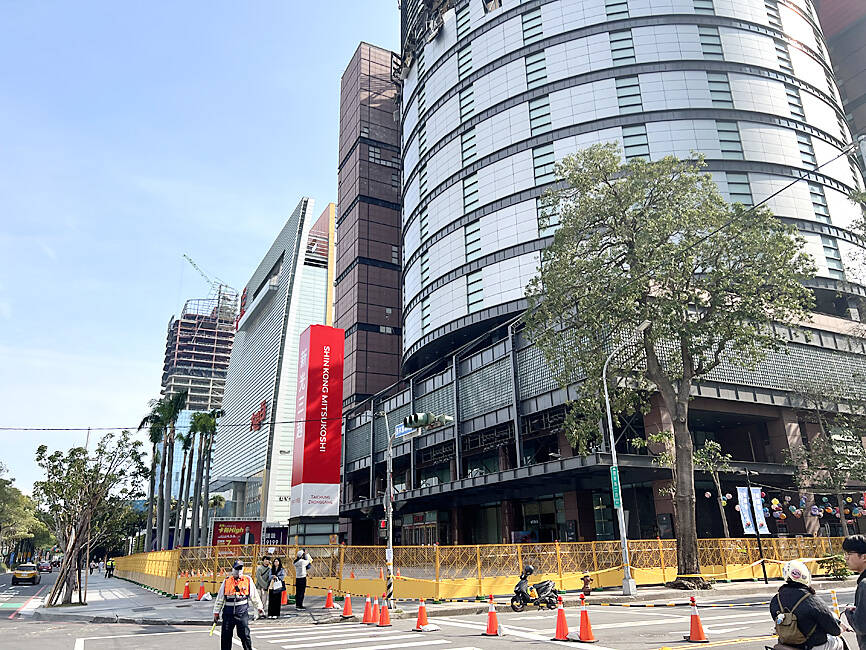An explosion at the Shin Kong Mitsukoshi Zhonggang Store in Taichung last month that left five people dead was caused by a gas leak, an official fire investigation report confirmed yesterday.
In a brief statement, the Taichung Fire Bureau said it had concluded its investigation into the Feb. 13 blast and found that it had been caused by a gas explosion.
The statement did not provide any other details from the report, other than identifying cigarette butts, electrical wires, a gas pipe and a circular saw as key evidence found at the scene.

Photo: CNA
The report, which was not released publicly, is to be handed over to prosecutors for further examination and potential legal action against those responsible, the bureau said.
However, sources familiar with the matter on Thursday said the leak likely occurred because of an ongoing project at the department store.
The department store had commissioned Shin Chung Natural Gas Co to shut off the main gas supply due to planned layout changes, the sources said.
However, residual gas likely remained in the branch pipes, which was not purged before construction work began, the sources said.
As a result, accumulated gas at the site ignited when a grinder was used to cut the pipes and it created sparks, triggering the explosion, they said.
Prosecutors said the explosion is being investigated as a case of negligent homicide, negligence resulting in injuries and public endangerment.
The incident occurred at about 11am on the 12th floor of the Taichung department store. The floor was undergoing construction work and was closed to the public.
Video footage of the explosion showed debris blasting from the building and scattering onto the streets below. The windows and exterior walls of the 12th floor were blown off, revealing the ruined interior.
Among the victims of the severe blast was a family of seven from Macau who had been passing by the department store at the time.
The grandparents perished in the blast, while a two-year-old girl, initially in critical condition, was airlifted back to Macau for treatment, but succumbed to her injuries on March 7, bringing the total death toll to five.

Trips for more than 100,000 international and domestic air travelers could be disrupted as China launches a military exercise around Taiwan today, Taiwan’s Civil Aviation Administration (CAA) said yesterday. The exercise could affect nearly 900 flights scheduled to enter the Taipei Flight Information Region (FIR) during the exercise window, it added. A notice issued by the Chinese Civil Aviation Administration showed there would be seven temporary zones around the Taiwan Strait which would be used for live-fire exercises, lasting from 8am to 6pm today. All aircraft are prohibited from entering during exercise, it says. Taipei FIR has 14 international air routes and

The Ministry of National Defense (MND) today released images of the military tracking China’s People's Liberation Army (PLA) movements during the latest round of Chinese drills around Taiwan. The PLA began "Justice Mission 2025" drills today, carrying out live-fire drills, simulated strikes on land and maritime targets, and exercises to blockade the nation's main ports. The exercises are to continue tomorrow, with the PLA announcing sea and air space restrictions for five zones around Taiwan for 10 hours starting from 8:30am. The ministry today released images showing a Chinese J-16 fighter jet tracked by a F-16V Block 20 jet and the

Snow fell on Yushan (Jade Mountain, 玉山) yesterday morning as a continental cold air mass sent temperatures below freezing on Taiwan’s tallest peak, the Central Weather Administration (CWA) said. Snowflakes were seen on Yushan’s north peak from 6:28am to 6:38am, but they did not fully cover the ground and no accumulation was recorded, the CWA said. As of 7:42am, the lowest temperature recorded across Taiwan was minus-5.5°C at Yushan’s Fengkou observatory and minus-4.7°C at the Yushan observatory, CWA data showed. On Hehuanshan (合歡山) in Nantou County, a low of 1.3°C was recorded at 6:39pm, when ice pellets fell at Songsyue Lodge (松雪樓), a

City buses in Taipei and New Taipei City, as well as the Taipei MRT, would on Saturday begin accepting QR code payments from five electronic payment providers, the Taipei Department of Transportation said yesterday. The new option would allow passengers to use the “transportation QR code” feature from EasyWallet, iPass Money, iCash Pay, Jkopay or PXPay Plus. Passengers should open their preferred electronic payment app, select the “transportation code” — not the regular payment code — unlock it, and scan the code at ticket readers or gates, General Planning Division Director-General Liu Kuo-chu (劉國著) said. People should move through the